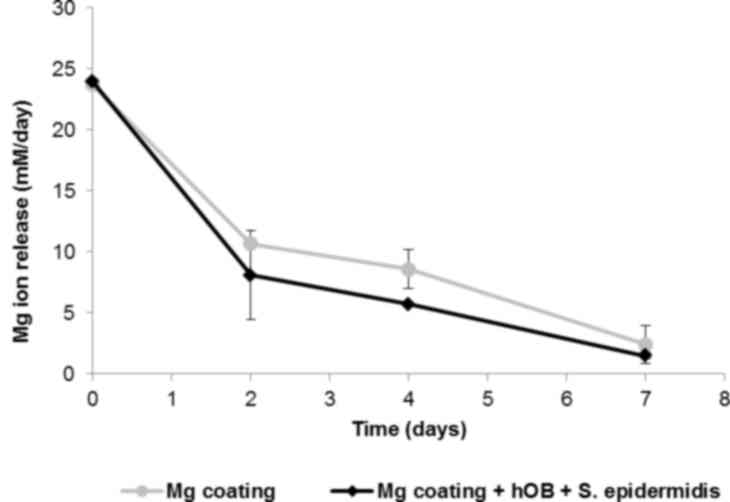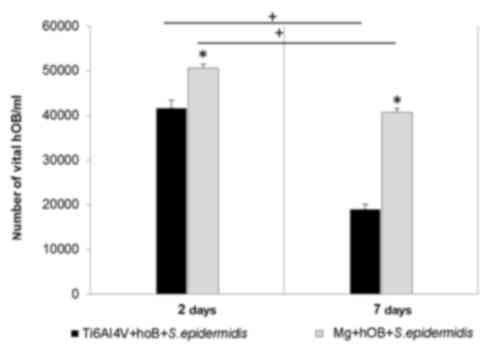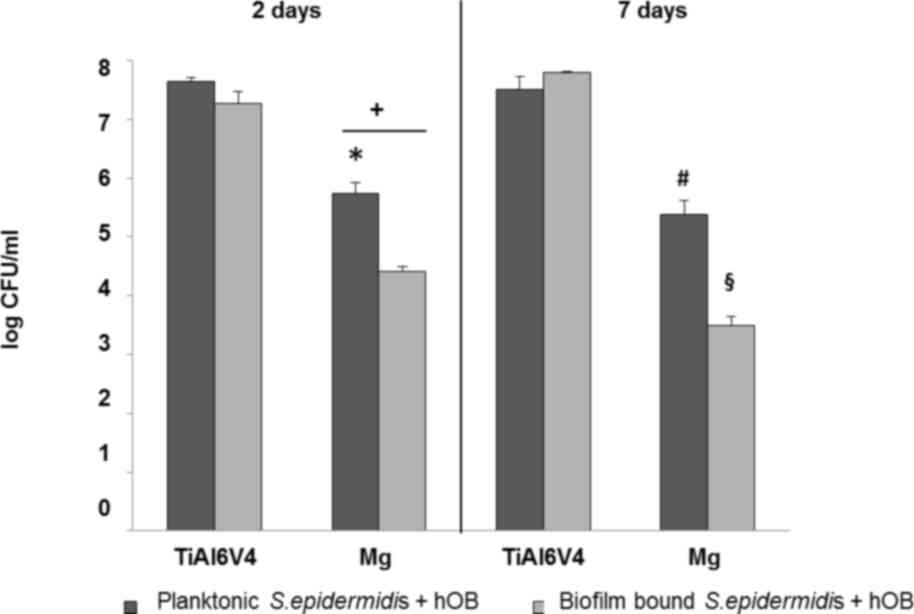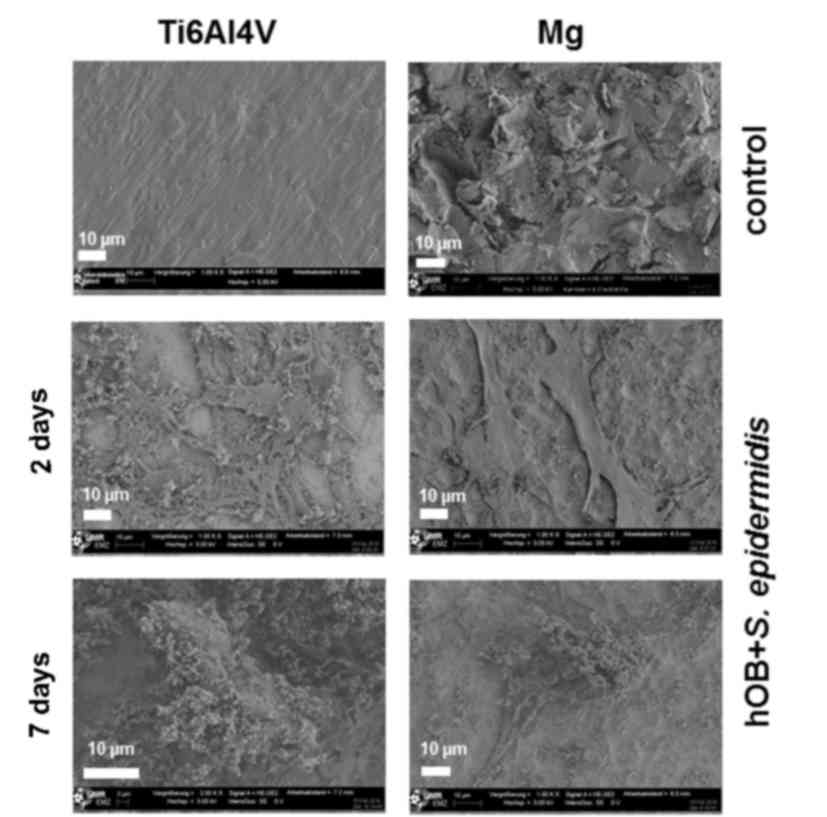|
1
|
Fallpauschalenbezogene
Krankenhausstatistik (DRG-Statistik): Operationen und Prozeduren
der vollstationären Patientinnen und Patienten der Krankenhäuser
(4-Steller). Statistisches Bundesamt (Destatis), Wiesbaden.
2015.
|
|
2
|
Darouiche RO: Treatment of infections
associated with surgical implants. N Engl J Med. 350:1422–1429.
2004. View Article : Google Scholar : PubMed/NCBI
|
|
3
|
Walter RP and Blake SM: Re: Two-stage
exchange for infected resurfacing arthroplasty use of a novel
cement spacer technique. J Arthroplasty. 26:9792011. View Article : Google Scholar : PubMed/NCBI
|
|
4
|
Harris LG and Richards RG: Staphylococci
and implant surfaces: A review. Injury. 37 Suppl 2:S3–S14. 2006.
View Article : Google Scholar : PubMed/NCBI
|
|
5
|
Casey AL, Lambert PA and Elliott TSJ:
Staphylococci. Int J Antimicrob Agents. 29 Suppl 3:S23–S32. 2007.
View Article : Google Scholar : PubMed/NCBI
|
|
6
|
Arciola CR, Campoccia D, Speziale P,
Montanaro L and Costerton JW: Biofilm formation in Staphylococcus
implant infections. A review of molecular mechanisms and
implications for biofilm-resistant materials. Biomaterials.
33:5967–5982. 2012. View Article : Google Scholar : PubMed/NCBI
|
|
7
|
Wilde AH and Ruth JT: Two-stage
reimplantation in infected total knee arthroplasty. Clin Orthop.
23–35. 1988.PubMed/NCBI
|
|
8
|
Vorndran E, Spohn N, Nies B, Rössler S,
Storch S and Gbureck U: Mechanical properties and drug release
behavior of bioactivated PMMA cements. J Biomater Appl. 26:581–594.
2012. View Article : Google Scholar : PubMed/NCBI
|
|
9
|
Uchiyama K, Takahira N, Fukushima K,
Moriya M, Yamamoto T, Minegishi Y, Sakai R, Itoman M and Takaso M:
Two-stage revision total hip arthroplasty for periprosthetic
infections using antibiotic-impregnated cement spacers of various
types and materials. ScientificWorldJournal. 2013:1472482013.
View Article : Google Scholar : PubMed/NCBI
|
|
10
|
Connaughton A, Childs A, Dylewski S and
Sabesan VJ: Biofilm disrupting technology for orthopedic implants:
What's on the Horizon? Front Med (Lausanne). 1:222014.PubMed/NCBI
|
|
11
|
Staiger MP, Pietak AM, Huadmai J and Dias
G: Magnesium and its alloys as orthopedic biomaterials: A review.
Biomaterials. 27:1728–1734. 2006. View Article : Google Scholar : PubMed/NCBI
|
|
12
|
Luthringer BJ, Feyerabend F and
Willumeit-Römer R: Magnesium-based implants: A mini-review. Magnes
Res. 27:142–154. 2014.PubMed/NCBI
|
|
13
|
Robinson DA, Griffith RW, Shechtman D,
Evans RB and Conzemius MG: In vitro antibacterial properties of
magnesium metal against Escherichia coliPseudomonas aeruginosa and
Staphylococcus aureus. Acta Biomater. 6:1869–1877. 2010. View Article : Google Scholar : PubMed/NCBI
|
|
14
|
Zaatreh S, Haffner D, Pasold J,
Kreikemeyer B, Mittelmeier W, Podbielski A, Quandt E and Bader R:
Track A. Biomaterials and biocompatibility 1. Biomed Tech (Berl).
60 Suppl 1:S1–S30. 2015. View Article : Google Scholar : PubMed/NCBI
|
|
15
|
Cytotoxicity test according to ISO
10993-5. CYTOX. 1999.
|
|
16
|
Zaatreh S, Wegner K, Strauß M, Pasold J,
Mittelmeier W, Podbielski A, Kreikemeyer B and Bader R: Co-culture
of S. epidermidis and human osteoblasts on implant surfaces: An
advanced in vitro model for implant-associated infections. PloS
One. 11:e01515342016. View Article : Google Scholar : PubMed/NCBI
|
|
17
|
Schlüter K, Zamponi C, Piorra A and Quandt
E: Comparison of the corrosion behaviour of bulk and thin film
magnesium alloys. Corros Sci. 52:3973–3977. 2010. View Article : Google Scholar
|
|
18
|
Jonitz A, Lochner K, Lindner T, Hansmann
D, Marrot A and Bader R: Oxygen consumption, acidification and
migration capacity of human primary osteoblasts within a
three-dimensional tantalum scaffold. J Mater Sci Mater Med.
22:2089–2095. 2011. View Article : Google Scholar : PubMed/NCBI
|
|
19
|
Anleitungen-Marienfeld-Superior.
[Internet]. [cited 3 Nov 2016]. http://www.marienfeld-superior.com/index.php/anleitungen.html
|
|
20
|
Von Eiff C, Peters G and Heilmann C:
Pathogenesis of infections due to coagulasenegative staphylococci.
Lancet Infect Dis. 2:677–685. 2002. View Article : Google Scholar : PubMed/NCBI
|
|
21
|
Wang HX, Guan SK, Wang X, Ren CX and Wang
LG: In vitro degradation and mechanical integrity of Mg-Zn-Ca alloy
coated with Ca-deficient hydroxyapatite by the pulse
electrodeposition process. Acta Biomater. 6:1743–1748. 2010.
View Article : Google Scholar : PubMed/NCBI
|
|
22
|
Kirkland NT, Lespagnol J, Birbilis N and
Staiger MP: A survey of bio-corrosion rates of magnesium alloys.
Corros Sci. 52:287–291. 2010. View Article : Google Scholar
|
|
23
|
Fischer J, Prosenc MH, Wolff M, Hort N,
Willumeit R and Feyerabend F: Interference of magnesium corrosion
with tetrazolium-based cytotoxicity assays. Acta Biomater.
6:1813–1823. 2010. View Article : Google Scholar : PubMed/NCBI
|
|
24
|
Fischer J, Pröfrock D, Hort N, Willumeit R
and Feyerabend F: Reprint of: Improved cytotoxicity testing of
magnesium materials. Mater Sci Eng B. 176:1773–1777. 2011.
View Article : Google Scholar
|
|
25
|
Schlüter K, Zamponi C, Hapke J, Hort N,
Kainer KU and Quandt E: Mechanical properties and corrosion
behaviour of freestanding, precipitate-free magnesium WE43 thin
films. Int J Mater Res. 104:286–292. 2013. View Article : Google Scholar
|
|
26
|
Schlüter K, Shi Z, Zamponi C, Cao F,
Quandt E and Atrens A: Corrosion performance and mechanical
properties of sputter-deposited MgY and MgGd alloys. Corros Sci.
78:43–54. 2014. View Article : Google Scholar
|
|
27
|
Sanchez AH Martinez, Luthringer BJC,
Feyerabend F and Willumeit R: Mg and Mg alloys: How comparable are
in vitro and in vivo corrosion rates? A review. Acta Biomater.
13:16–31. 2015. View Article : Google Scholar : PubMed/NCBI
|
|
28
|
Willumeit R, Feyerabend F and Huber N:
Magnesium degradation as determined by artificial neural networks.
Acta Biomater. 9:8722–8729. 2013. View Article : Google Scholar : PubMed/NCBI
|
|
29
|
Charyeva O, Neilands J, Svensäter G and
Wennerberg A: Bacterial biofilm formation on resorbing magnesium
implants. Open J Med Microbiol. 5:1–11. 2015. View Article : Google Scholar
|
|
30
|
Gasol JM and Del Giorgio PA: Using flow
cytometry for counting natural planktonic bacteria and
understanding the structure of planktonic bacterial communities.
Sci Mar. 64:197–224. 2000. View Article : Google Scholar
|
|
31
|
Lee JH, Wang H, Kaplan JB and Lee WY:
Microfluidic approach to create three-dimensional tissue models for
biofilm-related infection of orthopaedic implants. Tissue Eng Part
C Methods. 17:39–48. 2011. View Article : Google Scholar : PubMed/NCBI
|
|
32
|
Kaji H, Camci-Unal G, Langer R and
Khademhosseini A: Engineering systems for the generation of
patterned co-cultures for controlling cell-cell interactions.
Biochim Biophys Acta. 1810:239–250. 2011. View Article : Google Scholar : PubMed/NCBI
|













